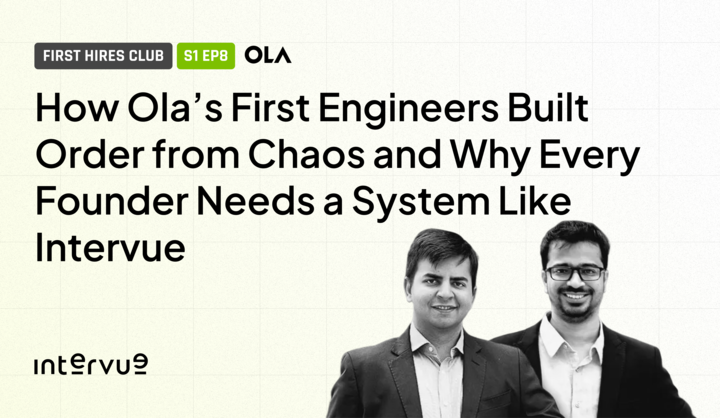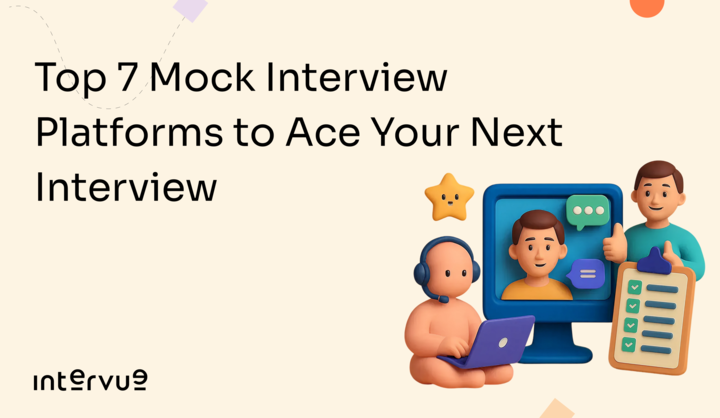How Ola’s First Engineers Built Order from Chaos and Why Every Founder Needs a System Like Intervue
When Intervue designs structured interview rubrics for engineering roles today, we bake in this same principle: can this candidate design for the edge case?

In the winter of 2011, a young founder in Mumbai stood on the side of the highway, stranded. His taxi driver had canceled mid-ride and refused to refund the fare. The frustration of that moment, a mix of helplessness and disbelief, would become the spark for one of India’s most transformative startups.
That founder was Bhavish Aggarwal, and the idea he carried home that evening became OlaCabs. But the real story of Ola isn’t just about an app that summoned cabs. It’s about a handful of early engineers who built a real-time, reliable mobility system in a country where reliability was a luxury.
And as we’ll soon see, it’s also about something that every founder today struggles with: finding the right first hires. The kind who thrive in ambiguity, solve for systems, and build things that don’t break. Back then, Ola found them by instinct. Today, Intervue.io gives every founder a structured way to do the same.
Finding the First Engineers Who Could Build Through Uncertainty
When Bhavish teamed up with his IIT Bombay batchmate Ankit Bhati, the odds were stacked against them.
India in 2011 wasn’t ready for real-time tech. GPS was unreliable, mobile networks dropped every few kilometers, and many cab drivers used entry-level smartphones that would freeze mid-ride.
Their first hires had to build for that environment. They weren’t just coding; they were crafting systems that would survive constant failure. Every line of code carried a silent question what if this breaks?
Ankit, Ola’s technical co-founder, led a team of young engineers who worked out of a small apartment in Powai. The Wi-Fi would crash during deploys, and servers had to be manually restarted at 2 a.m. Yet somehow, within months, they built a product that worked well enough for real rides across Mumbai.
There were no playbooks, no frameworks, and certainly no interview rubrics. Ola’s first engineers were hired through conviction, often after long conversations, gut instinct, and a shared sense of urgency.
In hindsight, they were exactly the kind of engineers every founder dreams of, those who don’t just write code, but create order from chaos.
That kind of talent isn’t found by luck anymore. It’s found through structured hiring, the kind Intervue enables every single day.
Turning Chaos into Code That Never Broke
What makes Ola’s early story so fascinating is how much of it was improvised and yet how disciplined the thinking behind it was.
The engineers had to make the impossible feel seamless. Drivers often went offline mid-ride, so the system had to guess where they were. Maps were missing entire neighborhoods, so engineers built fallback logic. Payment gateways were flaky, so they built transaction queues that reconciled automatically.
They didn’t call it “chaos engineering” back then. But that’s exactly what they were doing, building for the edge case first.
The system had to work on the worst day, not just the best.
And behind that was a mindset: every bug was a lesson, every failure was data. Engineers wrote logs for everything. They tracked driver acceptance times, ride cancellations, payment errors, and GPS accuracy. The Ola backend became a self-learning organism, one that could adapt faster than the chaos around it.
When Intervue designs structured interview rubrics for engineering roles today, we bake in this same principle: can this candidate design for the edge case? Because great systems are not defined by how they perform when things go right but by how they survive when everything goes wrong.
The Culture of Builders Who Fixed Before They Blamed
Ask anyone who was there in Ola’s first two years, and they’ll tell you: there was no room for ego.
If something broke, engineers didn’t point fingers; they opened their laptops. Everyone fixed everything. An Android developer would debug a backend script; an ops manager would test driver app flows.
That culture of ownership came from how Bhavish and Ankit hired. They didn’t care about titles or pedigrees. They cared about thinking. If you could reason through a problem, explain your decisions, and show grit, you were in.
But here’s the irony: back then, Ola’s founders had to rely on instinct to identify that mindset. There were no standardized ways to test for it.
Today, Intervue has turned that instinct into a science.
Our expert interviewers assess not just coding ability, but structured thinking — how engineers handle ambiguous problem statements, reason through constraints, and prioritize under pressure.
Because in every high-growth startup, you don’t just need smart engineers. You need engineers who stay calm when the system’s on fire.
Scaling Ola from a Powai Apartment to a National Network
By 2014, Ola was no longer a scrappy experiment. It had spread to multiple cities, clocking thousands of rides daily. The early architecture, a mix of modular services for matching, routing, and payments, started showing cracks.
The engineers who had once built on instinct now had to engineer for scale. They refactored code, automated ops, and designed a system that could handle millions of concurrent users.
The results were astonishing.
According to Tracxn, Ola raised $3.8 billion across 25 rounds, including $1.1 billion from Tencent in 2017, to fuel its nationwide expansion. By 2019, it operated in 250+ cities with a 2.5 million driver base, capturing nearly half of India’s ride-hailing market (Tofler, Uber filings).
But scale brought a new challenge: talent. The company needed engineers who could think systemically, make architectural trade-offs, and build teams that could sustain the chaos.
And that’s where structured hiring, the kind that Intervue now automates, becomes the difference between scaling gracefully and breaking painfully.
How Ola’s Electric Vision Tested Its Engineering DNA
In 2017, Ola made a bold move into electric mobility. Ola Electric wasn’t just a product pivot; it was a cultural one. Software engineers now had to work with hardware, firmware, and factories.
The same DNA that built resilient systems now powers electric vehicles. Ola’s EV engineers applied the same logic to battery management and sensor systems that their predecessors had applied to ride-matching algorithms.
Of course, it wasn’t perfect scaling in hardware that came with recalls, safety concerns, and operational hiccups. But what kept Ola Electric from collapsing was the same principle that had guided Ola’s first engineers: instrument everything, learn fast, and fix faster.
That’s the mindset Intervue helps hiring teams identify today, builders who thrive in the unknown.
The Hiring Lesson Every Founder Can Learn from Ola’s First Ten Engineers
If there’s one lesson every founder can take from Ola’s early journey, it’s this:
Your first ten engineers decide the fate of your next hundred.
They shape your tech DNA, define your execution rhythm, and decide whether your systems scale or stall.
Ola’s early hires had three defining traits:
- They built for failure, not just success.
- They took ownership without waiting for permission.
- They obsessed over the problem, not the title.
Those traits made Ola resilient in the face of chaos.
But here’s the catch, those traits don’t show up in a résumé. They show up in how someone thinks, argues, prioritizes, and solves.
That’s exactly what Intervue.io helps you measure.
Our live coding and structured interview platform lets you test engineers on what truly matters: their thinking. Not just “can they code?” but “can they build systems that survive chaos?”
We’ve helped companies like Nykaa, Razorpay, NPCI, and British Petroleum build teams that think like Ola’s first engineers; system-first, feedback-driven, outcome-obsessed.
Because talent isn’t just skill. It’s a mindset. And mindset can be measured, if you know what to look for.
How Intervue Helps Founders Hire Engineers Who Think in Systems
When Ola started, Bhavish didn’t have tools like Intervue. He hired through intuition, long conversations, and a bit of luck. Thankfully, he got it right.
But luck isn’t a hiring strategy anymore. Startups today move faster, hire globally, and can’t afford to miss on their first five technical hires.
That’s why structured hiring is no longer optional. It’s infrastructure.
The same way Ola built infrastructure for movement, Intervue builds infrastructure for technical hiring — live interviews, rubric-based assessments, and real-time analytics that help you see not just who’s good, but who’s right for your system.
Because in the end, building a great company isn’t about perfect code. It’s about hiring people who can write imperfect code in an imperfect world and still make it work.
The Legacy of Builders Who Created Order from Chaos
Fifteen years later, Ola has become more than a mobility company. It’s a symbol of how engineering ingenuity can solve India-scale problems. But beneath that success lies something more fundamental, a culture of builders who believed structure could emerge from chaos.
That same belief powers Intervue today. We exist so every founder, whether in fintech, AI, or mobility, can find the kind of engineers who built Ola. The kind who don’t just ship features, but shape futures.
Ola’s story reminds us that a handful of engineers can rewrite a nation’s infrastructure.
Intervue’s mission is to help you find yours.



